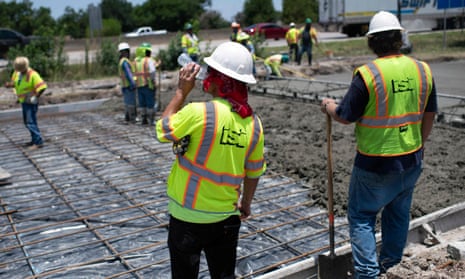Eva Marroquin is an outdoor worker who cleans up construction sites in the Austin area, where temperatures have surpassed 100F (38C) every day for weeks. In the summertime, it’s common for Marroquin to feel blistering heat as early as 8.30 in the morning. She is required to wear stifling layers of protective clothing.
She has seen workers pass out from working in dangerous weather conditions, and she herself has experienced heat exhaustion at least three times during her career. “I’d get really red in the face and feel very lethargic, like I didn’t have any strength to move, with my heart palpitating really fast,” she said. Marroquin relies on regular water breaks to get some relief.
These breaks are obligatory under local law in Austin. But recently, amid a record-breaking heatwave, the Texas governor signed a bill that will rescind existing mandatory rest and water breaks for construction workers starting in September. Outdoor workers like Marroquin and others are angry, as well as fearful of the potential repercussions.
“It’s inhumane and cruel,” Marroquin said through a translator. “Taking a break is a very minimal, basic level of human rights.”
A Republican who introduced the bill justified it on the basis that “progressive municipal officials and agencies have made Texas small businesses jump through contradictory and confusing hoops”.
The move has attracted national attention. Joe Biden criticized the bill – which critics have called the “Death Star” – at a White House event with the mayor of San Antonio.
“The idea that you can’t have mandatory water breaks when you’re working on a construction? I mean, what are we doing here?”
Taking water breaks is already a fraught practice in much of Texas. “We’ve heard from workers that taking rest breaks is very stigmatized in the construction industry, because that signifies potential delays to get projects completed,” said Christine Bolaños of Workers Defense Project, a Texas-based community organization for immigrant workers in construction.
Austin and Dallas are the only places in Texas where such protections exist, requiring 10-minute breaks every four hours for workers at a construction site. Marroquin says that the mandated breaks vary from site to site, and from her experience, locations within Austin city limits tend to follow the ordinance precisely. Those just outside the city limits are not required to follow the rule.
“I know construction workers who have passed away at the site – they all hit me personally because that could be me,” Marroquin said.
To protest Abbot’s move, last Tuesday a Texas Democratic congressman, Greg Casar, went on a nine-hour thirst strike on the steps of the US Capitol in Washington DC, where the temperature reached 90F.

“The governor is trying to win the cruelty Olympics,” Casar said in an interview. “This bill could kill workers and it shows that he’s putting profits over the people that have entrusted him with this job.”
Back in 2010 he staged a similar thirst strike that helped pass Austin’s citywide water breaks for construction workers.
“This fight is about water breaks, but most importantly it’s about dignity on the job and respecting the people who build our economy,” Casar said. “We need rest breaks and shade and water for workers but we also need a living wage.”
after newsletter promotion
People of color are especially vulnerable to extreme heat. More than 40% of all outdoor workers in the US are Black or Hispanic, despite making up roughly 32% of the population.
Regulations to protect outdoor workers from extreme heat only exist in six states: California, Colorado, Maryland, Nevada, Oregon and Washington. There is no federal law that guarantees water breaks, rest or shade, but in 2021 the Biden Administration ordered Occupational Safety and Health Administration (Osha) to produce heat safety standards. These standards have not yet been issued.
Atoung Angis is another Texas worker who knows the importance of water breaks. While not officially classified as an outdoor worker, she is regularly exposed to intense heat through her work as a wheelchair assistant bringing passengers in and out of planes at Dallas Fort Worth international airport. Much of her time is spent inside a jet bridge, where the air conditioning is often turned off.
“It’s like an oven, that’s how bad it is,” Angis, who has worked in this field for 20 years, said. “And you don’t get time to sit down and cool off, or get a drink of water.” She is allowed water breaks, but says they are frequently impractical because she is often so far from the designated break area. And on international flight assignments she cannot carry her water bottle because she crosses security checkpoints. “It can be three to four hours without drinking water,” Angis said.
Houston and San Antonio are suing the state of Texas over the new law, arguing that the legislation would limit the cities’ autonomy and is an example of state overreach.
A recent tragedy has sharpened focus on the issue. Last month the mother of Gabriel Infante, a 24-year-old construction worker who died on 23 June 2022 from severe heatstroke in San Antonio, filed a lawsuit against his employer, B Comm Constructors. According to to the Washington Post, she alleges that the firm created “an extreme degree of risk” for workers because it lacked first aid procedures, failed to provide shaded rest areas, and did not change work hours amid extreme heat.
“All of these deaths are preventable,” said Kristie Ebi, a professor of environmental and occupational health at the University of Washington. Upon his death at the hospital, Infante’s internal temperature was 109.8F. A heatstroke can occur when the body temperature reaches 103F or higher.
“If somebody had been paying attention, if they’d had the proper precautions on the construction site, he would have had water, he would have had access to shade, he would have taken a break. His core body temperature wouldn’t have gotten so high and he wouldn’t have died,” Ebi said.
